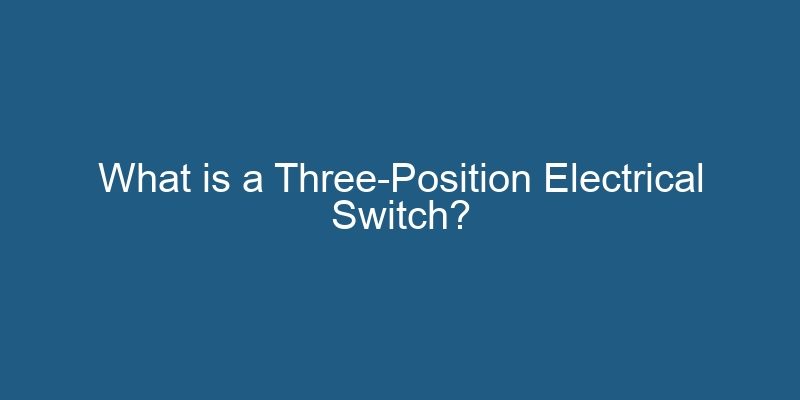An electrical switch is a device used to interrupt or divert the flow of electric current. It allows us to control the operation of various electrical appliances and systems. Among the different types of switches, one commonly used is the three-position electrical switch. In this article, we will delve into the details of what a three-position electrical switch is, its working principle, applications, and advantages.
- 1. Understanding the Basics of an Electrical Switch
- 2. Introduction to Three-Position Electrical Switches
- 2.1 How Does a Three-Position Switch Work?
- How to wire a 3-way switch
- How the 3 Position Selector Switch Works
- 3. Applications of Three-Position Electrical Switches
- 3.1 Lighting Control
- 3.2 Motor Control
- 3.3 HMI (Human-Machine Interface) Panels
- 4. Advantages of Three-Position Electrical Switches
- 4.1 Increased Control Options
- 4.2 Simplified Circuitry
- 4.3 Enhanced Safety
- 5. Frequently Asked Questions (FAQs)
- Can a three-position electrical switch be used as a simple on-off switch?
- Can a three-position switch be used to control more than two circuits?
- Is it possible to create custom circuit configurations using a three-position switch?
- Can I use a three-position switch to control the speed of a motor?
- Are three-position switches weatherproof?
- Can I install a three-position switch myself?
- Are three-position switches compatible with all types of lighting fixtures?
- Do three-position switches consume electricity when in the intermediate position?
- Can I use a three-position switch in a DC (direct current) circuit?
- Where can I purchase three-position electrical switches?
- 6. Conclusion
1. Understanding the Basics of an Electrical Switch
Before diving into the specifics of a three-position electrical switch, let’s briefly understand the basics of an electrical switch.
An electrical switch, as the name suggests, is a device that enables or disables the flow of electric current in a circuit. It acts as a control mechanism, allowing manual control over the electrical system. When the switch is closed (turned on), the circuit is complete, and current can flow through it. Conversely, when the switch is open (turned off), the circuit is broken, and current cannot pass through. This simple functionality makes switches an integral part of our everyday lives.
2. Introduction to Three-Position Electrical Switches
A three-position electrical switch, also known as a three-way switch, is a type of switch that provides three different output options. It allows the user to choose between three distinct states or positions, each corresponding to a different circuit configuration.
Unlike a simple on-off switch, which only has two positions (on and off), a three-position switch adds an extra intermediary position, providing more control options. This additional position enables the user to select between two different circuits or combinations of circuits.
2.1 How Does a Three-Position Switch Work?
A three-position electrical switch typically consists of three terminals or connection points. These terminals are labeled as “common,” “normally open,” and “normally closed.”
In the default or middle position, the common terminal is connected to both the normally open and normally closed terminals. This configuration allows the switch to act as a crossover switch, toggling between two separate circuits.
When the switch is toggled to one side, the common terminal disconnects from the normally closed terminal and connects to the normally open terminal. This action establishes one circuit while breaking the other. Toggling the switch to the opposite side reverses the connections, activating the second circuit while disabling the first.
How to wire a 3-way switch
How the 3 Position Selector Switch Works
3. Applications of Three-Position Electrical Switches
Three-position electrical switches find applications in various industries and everyday devices. Some common applications include:
3.1 Lighting Control
Three-position switches are commonly used for controlling lights in residential, commercial, and industrial settings. They enable the user to control multiple light fixtures or lighting zones from different switch locations.
3.2 Motor Control
In motor control systems, three-position switches are utilized to switch between different operational modes or directions of rotation. They provide a convenient way to change the motor’s behavior without the need for complex wiring modifications.
3.3 HMI (Human-Machine Interface) Panels
Three-position switches are often incorporated into HMI panels in industrial environments. They serve as selector switches, allowing operators to choose between different machine states or operational modes.
4. Advantages of Three-Position Electrical Switches
Three-position electrical switches offer several advantages over traditional two-position switches. Some notable advantages include:
4.1 Increased Control Options
The additional intermediate position in a three-position switch provides increased control options compared to a simple on-off switch. This allows for more flexibility in circuit configurations and device operation.
4.2 Simplified Circuitry
Using a three-position switch can simplify circuitry, especially in applications where multiple switches are used to control different aspects of a system. By utilizing a three-position switch, the need for additional switches can be reduced, leading to simplified wiring and cost savings.
4.3 Enhanced Safety
Three-position switches can contribute to enhanced safety in certain applications. By providing clear visual feedback on the switch’s current position, users can quickly identify the active circuit and prevent accidental activation or deactivation of critical systems.
5. Frequently Asked Questions (FAQs)
-
Can a three-position electrical switch be used as a simple on-off switch?
Yes, a three-position electrical switch can be used as a simple on-off switch by connecting the common terminal to either the normally open or normally closed terminal and leaving the other terminal unconnected.
-
Can a three-position switch be used to control more than two circuits?
No, a standard three-position switch is designed to toggle between two circuits. If you need to control more than two circuits, you would require a different type of switch, such as a multi-position switch.
-
Is it possible to create custom circuit configurations using a three-position switch?
Yes, by utilizing additional electrical components such as relays or diodes, it is possible to create custom circuit configurations using a three-position switch. However, this may require advanced knowledge of electrical circuits.
-
Can I use a three-position switch to control the speed of a motor?
No, a three-position switch is not suitable for controlling the speed of a motor. To control motor speed, specialized motor control devices like variable frequency drives (VFDs) or motor speed controllers are used.
-
Are three-position switches weatherproof?
Not all three-position switches are weatherproof. If you require a switch for outdoor or harsh environments, make sure to choose a switch specifically designed for such conditions.
-
Can I install a three-position switch myself?
If you have basic knowledge of electrical wiring and safety precautions, you can install a three-position switch yourself. However, it is recommended to consult a licensed electrician for complex installations or if you are unsure about the process.
-
Are three-position switches compatible with all types of lighting fixtures?
Three-position switches are compatible with most standard lighting fixtures. However, certain specialized lighting systems may require specific switches or dimmers.
-
Do three-position switches consume electricity when in the intermediate position?
No, three-position switches do not consume electricity when in the intermediate position. The switch simply redirects the flow of current, and there is no power consumption involved in maintaining the intermediate state.
-
Can I use a three-position switch in a DC (direct current) circuit?
Yes, three-position switches can be used in both AC (alternating current) and DC circuits. However, it is important to ensure that the switch’s voltage and current ratings are suitable for the specific circuit.
-
Where can I purchase three-position electrical switches?
Three-position electrical switches can be purchased from various electronic component suppliers, electrical supply stores, and online retailers specializing in electrical components.
6. Conclusion
In conclusion, a three-position electrical switch adds an extra layer of control and versatility to electrical circuits. With its ability to toggle between two different circuit configurations, it finds applications in various industries, including lighting control, motor control, and HMI panels. The advantages offered by three-position switches, such as increased control options, simplified circuitry, and enhanced safety, make them a valuable component in electrical systems. By understanding the working principle and applications of three-position electrical switches, users can harness their potential and optimize the control of electrical appliances and systems.










